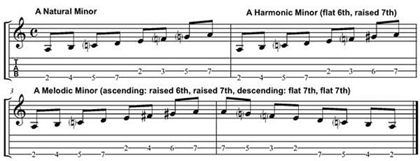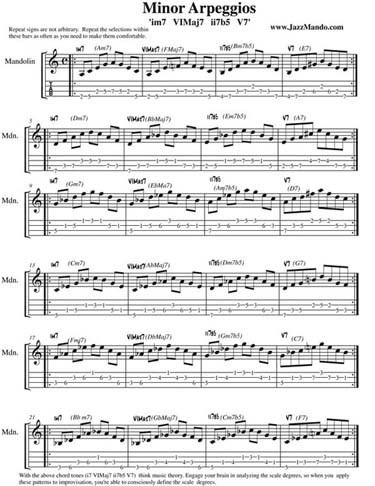« Aaron Weinstein on chord melody |
Main
| Jason Anick on effective soloing »
 January 23, 2014 | The esoteric Minor Scale January 23, 2014 | The esoteric Minor Scale
The following is an excerpt from our December 2011 Mandolin Sessions article tackling the minor scale. As you read, it's easy to get bogged down in the cerebral details, and really the point of the topic is ultimately application will default to context. It's good to know the ins and outs, but when you get down to it, what sounds good is always the answer.
Ask us what time it is, we tell you how to build a watch.
Three scales.
The simplest form of Minor Scale is the Natural Minor. It deviates from a Major Scale in that the 6th and 7th scale degrees are lowered a half step, or m6th and m7th. An A Major would include an F# and G#. In the A Natural Minor you'd have F natural and G Natural.
Here's the problem. Harmonically, the G natural does not pack the gravity of the magic half step drive. When you're spelling out the dominant V7 chord in the key (E G# B D), unless you raise that G to a G#, you have an awkward clash between the G and G#. The solution is always to raise the 7th scale degree, and if nothing else is changed, you have the Harmonic Minor Scale.
If you play it through, you'll notice (and finger) an awkward 3 half-step gap (3 fret) between the 6th and 7th scale degree. Playing through it melodically can give it a characteristic ethnic sound (Klezmer, for example), but in some music it doesn't flow as well as when you raise the 6th scale degree.
That's your solution (raising the 6th), but there's a problem when you have the F Major Chord based on the 6th scale degree (F, A, C, E). Again, you'd have a half-step clash with the F natural and F#. The compromise: raise them going in one direction (F#, G#), lower them going in the other (F, G).

The thing is, this is all pretty cerebral. There's no rule in real life you always raise going up, and always lower going down, because real music jumps around, skips, and turns. What do you do then?
We have to remember that scales are exercises, mere snippets of music and an incarnation of theory, not always application. You can drill these three forms all you want, but we'd argue you can waste valuable practice time mastering these. You would probably be better off spending time with yet another form of minor, the modal scale known as Dorian.
Read more, Minor League: Making the most of Minor Keys
Follow up: Spelling out the Chords. Melodically.

Posted by Ted at January 23, 2014 8:07 AM

Disclaimer: In the 'Information Age' of the 21st Century,
any fool with a computer, a modem, and an idea can
become a self-professed 'expert." This site does not
come equipped with 'discernment.'
|



